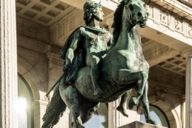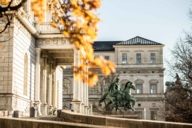
The Academy of Fine Arts Munich is one of the oldest and most important art schools in Germany. Its students also get to study at one of the most beautiful places in the city. Its alumni include many world-famous creative minds.
Some of its graduates include names like Wassily Kandinsky, Paul Klee, Franz Marc, Franz von Stuck, Richard Riemerschmid and Andreas von Weizsäcker, the son of the former President of Germany. Wilhelm Busch, Otl Aicher, Max Unold, Lovis Corinth and Giorgio de Chirico also studied here, as well as Johann Baptist Stiglmaier, Friedrich von Gärtner, Franz von Lenbach und Max Ainmiller, who have squares and streets named after them in Munich. The academy currently educates 700 students in the fields of painting, sculpture, interior design, photography, glassware, ceramics, jewellery and artefacts, stage design and costume, high school art education, and art therapy.
Classes are taught in a Wilhelminian-style building behind the Siegestor gate, which is a great work of art itself. The neo-renaissance palace was designed by Gottfried von Neureuther from 1876 to 1885. The open staircase with the bronze figures of the riders Castor and Pollux was conceptualised by Max von Widnmann. The architectural work of art is rounded off with a modern glass and steel extension that was added in 2005. This was designed by the avant-garde architectural office “Coop Himmelb(l)au”, which is also responsible for the famous façade at BMW Welt.

The history of the academy dates back to the year 1770. Elector Maximilian III Joseph founded a drawing school, which then became the “Royal Academy of Fine Arts” under King Max I Joseph in 1808. Even back then, the educational focus was on painting, graphics, sculpture and architecture. The academy moved into the newly completed building in 1886, where it is still housed today.
It was renowned as one of the world’s leading institutions in the mid-19th century and still had an enormous influence on the world of art at the turn of the century. This changed when the Bavarian Soviet Republic was crushed at the end of the First World War, leaving a climate of repression in its wake. During the Second World War, Hitler replaced the academy’s “non-Aryan” professors with Nazi artists. Large parts of the building were destroyed in a bombing raid in July 1944. Extensive collections of artwork, plaster casts, costumes and archives were lost forever.
After the Second World War, the military government dismissed former members of the Nazi Party and artists from the Nazi era. However, certain artists like Professor Hermann Kaspar, who had been a key cultural figure in the Third Reich, managed to hold on to their posts until protests staged by artists at the academy became too strong in the 1960s and 1970s. The institution was even closed by the Minister of Culture during the wild student movements. However, this decision was quickly overruled by the Administrative Court.
The academy’s annual exhibition in July is well worth a visit. Guests can get a glimpse of the work that is currently being carried out in the studios and student workshops. Students and graduates also exhibit their work in the academy gallery at the Universität subway station throughout the year. A glass wall is the only thing that separates the 20-metre-long and 8-metre-deep showroom from the rest of the concourse, where it can be seen in all its glory.